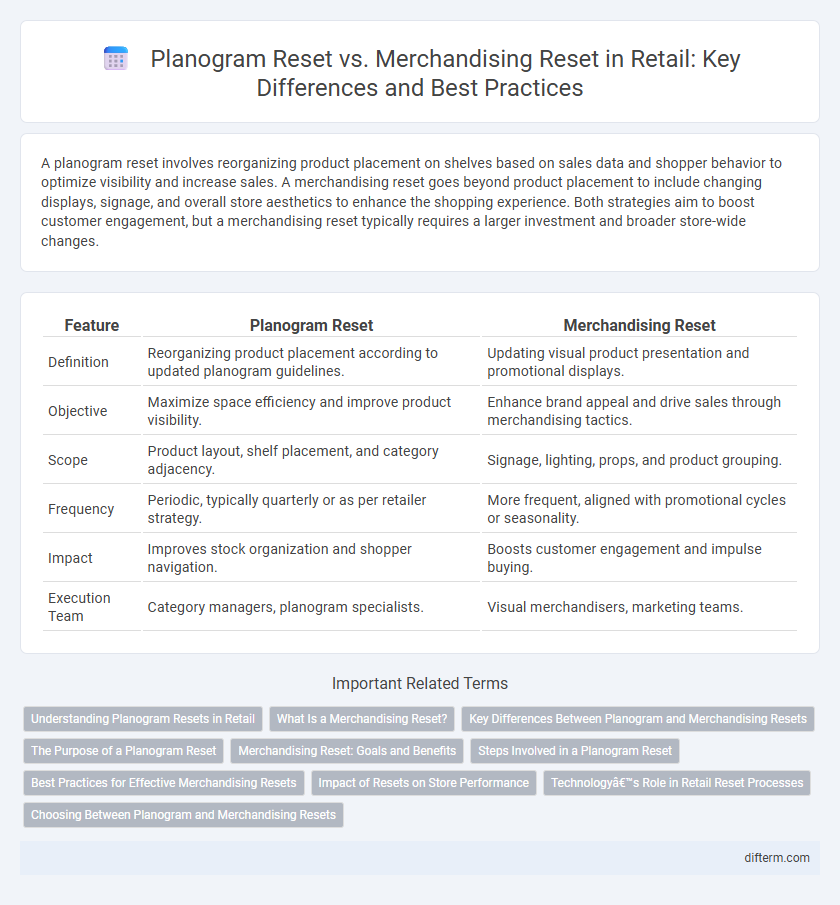A planogram reset involves reorganizing product placement on shelves based on sales data and shopper behavior to optimize visibility and increase sales. A merchandising reset goes beyond product placement to include changing displays, signage, and overall store aesthetics to enhance the shopping experience. Both strategies aim to boost customer engagement, but a merchandising reset typically requires a larger investment and broader store-wide changes.
Table of Comparison
| Feature | Planogram Reset | Merchandising Reset |
|---|---|---|
| Definition | Reorganizing product placement according to updated planogram guidelines. | Updating visual product presentation and promotional displays. |
| Objective | Maximize space efficiency and improve product visibility. | Enhance brand appeal and drive sales through merchandising tactics. |
| Scope | Product layout, shelf placement, and category adjacency. | Signage, lighting, props, and product grouping. |
| Frequency | Periodic, typically quarterly or as per retailer strategy. | More frequent, aligned with promotional cycles or seasonality. |
| Impact | Improves stock organization and shopper navigation. | Boosts customer engagement and impulse buying. |
| Execution Team | Category managers, planogram specialists. | Visual merchandisers, marketing teams. |
Understanding Planogram Resets in Retail
Planogram resets in retail involve reorganizing product placement according to a detailed visual plan that maximizes shelf space and enhances product visibility, directly influencing consumer purchasing behavior. This process requires analyzing sales data and shopper traffic patterns to strategically position high-demand items and seasonal promotions, increasing overall revenue. Unlike merchandising resets that often focus on aesthetic or thematic updates, planogram resets prioritize data-driven product arrangement to optimize inventory display and improve stock replenishment efficiency.
What Is a Merchandising Reset?
A merchandising reset involves reorganizing and updating product displays on shelves to enhance visual appeal and improve the customer shopping experience. This process includes changing product placement, adjusting shelf heights, and incorporating new promotional materials to align with current marketing strategies. A merchandising reset aims to boost sales by optimizing product visibility and driving shopper engagement within the retail environment.
Key Differences Between Planogram and Merchandising Resets
Planogram resets focus on the strategic layout and placement of products based on data-driven insights to optimize shelf space and improve inventory management. Merchandising resets emphasize visual presentation and promotional displays to enhance customer engagement and drive sales through aesthetic appeal. Key differences include the technical precision of planograms versus the creative flexibility of merchandising resets in shaping the in-store shopping experience.
The Purpose of a Planogram Reset
A planogram reset aims to optimize product placement by updating visual merchandising layouts to enhance customer experience and maximize sales floor efficiency. It ensures strategic product positioning based on current shopper behavior, inventory trends, and promotional priorities. This targeted restructuring improves product visibility and accessibility, driving increased purchase intent and overall retail performance.
Merchandising Reset: Goals and Benefits
Merchandising reset aims to redefine product placement and presentation to boost sales, improve brand visibility, and enhance the customer shopping experience. It involves updating displays, signage, and shelf arrangement to align with current marketing strategies and consumer trends. Benefits include increased product turnover, optimized shelf space utilization, and strengthened brand engagement.
Steps Involved in a Planogram Reset
Planogram reset involves a detailed analysis of product placement based on sales data and customer behavior to optimize shelf space and enhance shopper experience. The steps include auditing current displays, redesigning the layout with updated SKU priorities, and physically rearranging products to align with the new planogram specifications. Effective planogram resets improve inventory turnover and drive higher sales compared to generic merchandising resets.
Best Practices for Effective Merchandising Resets
Effective merchandising resets prioritize accurate planogram resets by aligning product placement with updated store layouts and consumer buying patterns to maximize shelf space and enhance visual appeal. Utilizing data-driven insights and regular performance analysis ensures that product assortments meet customer demand while maintaining inventory efficiency. Consistent staff training on reset procedures and real-time monitoring of planogram compliance further boost execution accuracy and overall sales performance.
Impact of Resets on Store Performance
Planogram resets strategically reorganize product placement to optimize shelf space and enhance product visibility, directly boosting sales and customer engagement. Merchandising resets encompass broader changes, including promotional displays and signage updates, driving foot traffic and improving the overall shopping experience. Both resets significantly impact store performance by increasing product turnover, maximizing space efficiency, and elevating brand perception.
Technology’s Role in Retail Reset Processes
Technology enhances retail reset processes by enabling precise planogram resets through AI-driven data analysis and 3D visualization, optimizing product placement and shelf space utilization. Merchandising resets benefit from digital tools like mobile apps and real-time inventory tracking, facilitating efficient stock management and dynamic promotional displays. Integrating IoT sensors and automated reporting systems ensures continuous monitoring and adaptation, elevating overall in-store operational efficiency.
Choosing Between Planogram and Merchandising Resets
Choosing between planogram and merchandising resets hinges on the desired impact on product placement and customer experience. Planogram resets emphasize data-driven shelf layouts to optimize space utilization and sales per square foot, while merchandising resets focus on visual appeal, seasonal themes, and brand storytelling to enhance shopper engagement. Retailers analyze sales patterns, inventory turnover, and consumer behavior to determine the most effective reset strategy for achieving business objectives.
planogram reset vs merchandising reset Infographic

 difterm.com
difterm.com